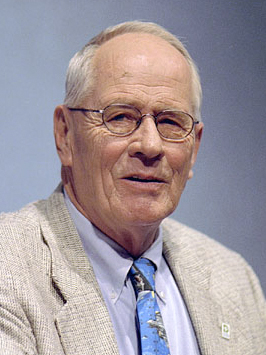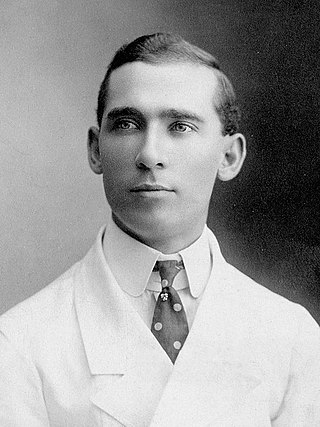
Stephen Edward Ambrose was an American historian, most noted for his biographies of U.S. Presidents Dwight D. Eisenhower and Richard Nixon. He was a longtime professor of history at the University of New Orleans and the author of many bestselling volumes of American popular history.

The Consolidated B-24 Liberator is an American heavy bomber, designed by Consolidated Aircraft of San Diego, California. It was known within the company as the Model 32, and some initial production aircraft were laid down as export models designated as various LB-30s, in the Land Bomber design category.

John Lewis Gaddis is an American military historian, political scientist, and writer. He is the Robert A. Lovett Professor of Military and Naval History at Yale University. He is best known for his work on the Cold War and grand strategy, and he has been hailed as the "Dean of Cold War Historians" by The New York Times. Gaddis is also the official biographer of the prominent 20th-century American diplomat and historian George F. Kennan. George F. Kennan: An American Life (2011), his biography of Kennan, won the 2012 Pulitzer Prize for Biography or Autobiography.

The American Historical Association (AHA) is the oldest professional association of historians in the United States and the largest such organization in the world. Founded in 1884, AHA works to protect academic freedom, develop professional standards, and support scholarship and innovative teaching. It publishes The American Historical Review four times annually, which features scholarly history-related articles and book reviews.

A gun turret is a mounting platform from which weapons can be fired that affords protection, visibility and ability to turn and aim. A modern gun turret is generally a rotatable weapon mount that houses the crew or mechanism of a projectile-firing weapon and at the same time lets the weapon be aimed and fired in some degree of azimuth and elevation.

Arthur L. Herman is an American popular historian. He is a senior fellow at Hudson Institute.

Thomas Sewall Adams was an American economist who was Professor of Political Economy at Yale University. He was advisor to the U.S. Treasury Department, and a key architect of the post-WWI fiscal state in the United States.
"The Death of the Ball Turret Gunner" is a five-line poem by Randall Jarrell published in 1945. The poem is about the death of a gunner in a Sperry ball turret on a World War II American bomber aircraft.
Robert David English is an American academic, author, historian, and international relations scholar who specializes in the history and politics of contemporary Eastern Europe, the USSR, and Russia. He is an associate professor of International Foreign Policy and Defense Analysis at the University of Southern California School of International Relations.

William Shepard was a United States representative from Massachusetts (1797–1802), and a military officer in the Continental Army during the American Revolutionary War. As a state militia leader he protected the Springfield Armory during Shays' Rebellion, firing cannon into the force of Daniel Shays and compelling them to disperse. He was also served in town and state government and was a member of the Massachusetts Governor's Council.

Shoo Shoo Shoo Baby, originally Shoo Shoo Baby, is a Boeing B-17 Flying Fortress in World War II, preserved and currently in storage at the National Museum of the United States Air Force, awaiting transfer to the Smithsonian's National Air and Space Museum. A B-17G-35-BO, serial number 42-32076, and manufactured by Boeing, it was named by her crew for a song of the same name made popular by The Andrews Sisters, the favorite song of its crew chief T/Sgt. Hank Cordes. Photographs of the bomber indicate that a third "Shoo" was added to the name at some point in May 1944 when the original aircraft commander completed his tour of duty and was replaced by another pilot.

A ball turret is a spherical-shaped, altazimuth mount gun turret, fitted to some American-built aircraft during World War II. The name arose from the turret's spherical housing.

No. 466 Squadron RAAF was a Royal Australian Air Force (RAAF) bomber squadron during World War II. Formed in the United Kingdom in late 1942, the squadron undertook combat operations in Europe until the end of the war, flying heavy bomber aircraft. Following the conclusion of hostilities with Germany, the squadron began retraining to undertake operations in the Pacific against the Japanese, but the war came to an end before it left the UK. In late 1945, the squadron was disbanded.

John Patrick Diggins was an American professor of history at the University of California, Irvine, Princeton University, and the City University of New York Graduate Center.
Louis Rudolph Harlan was an American academic historian who wrote a two-volume biography of the African-American educator and social leader Booker T. Washington and edited several volumes of Washington materials. He won the Bancroft Prize in 1973 and 1984, once for each volume, and the 1984 Pulitzer Prize for Biography or Autobiography for the second volume.
Bradford Perkins was an American historian who spent the bulk of his career at the University of Michigan. He was the son of the historian Dexter Perkins.
Frederic C. Lane was a historian who specialized in Medieval history with a particular emphasis on the region of Venice.
Ronald Smelser is an American historian, author, and former professor of history at the University of Utah. He specializes in modern European history, including the history of Nazi Germany and the Holocaust, and has written several books on these topics. Smelser is the author, together with fellow historian Edward J. Davies, of the 2008 book The Myth of the Eastern Front: The Nazi-Soviet War in American Popular Culture.

Boeing B-17G Flying Fortress No.44-83690 is a B-17 Flying Fortress heavy bomber currently undergoing restoration at the Museum of Aviation near Robins Air Force Base in Georgia. It was built as a B-17G-95-DL by the Douglas Aircraft Company and delivered for use on May 9, 1945. It was flown to Grissom Air Force Base for display as a museum piece in 1961. The plane was listed on the National Register of Historic Places in 1993. It was moved to the Museum of Aviation in August 2015.
Beth Bailey is an American historian who writes about U.S. military history and the history of gender and sexuality.













